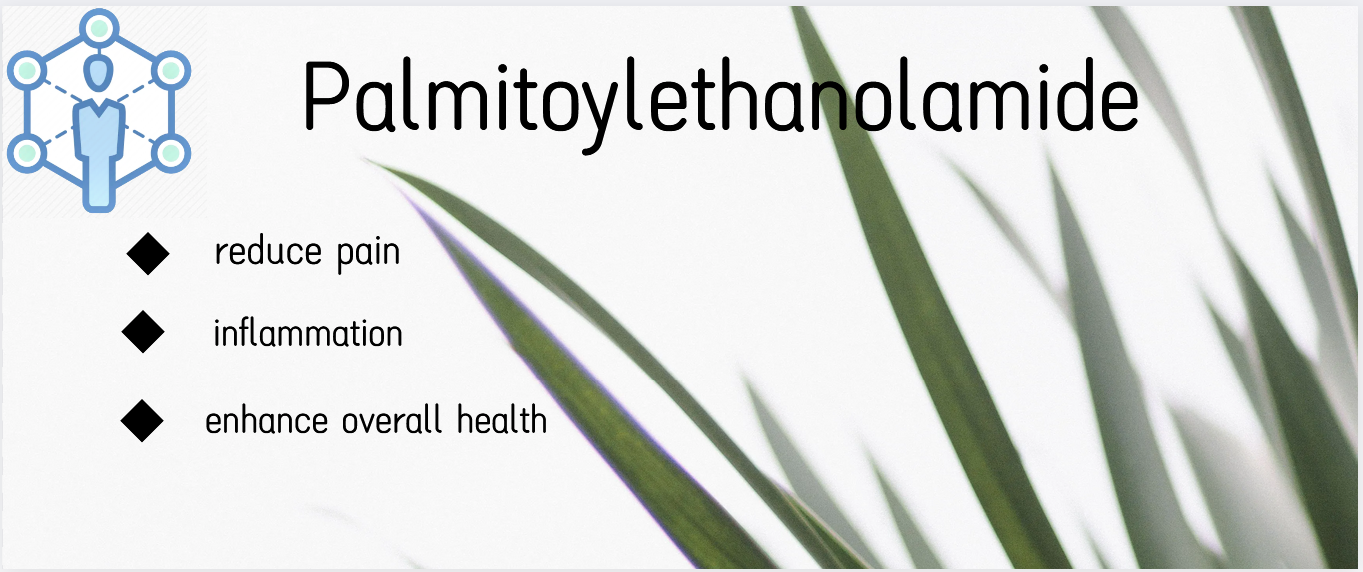In recent years, people have lived more health-conscious lives, and in the quest for optimal health and wellness, we often look for natural solutions to a variety of ailments. One promising supplement that has gained attention in recent years is palmitoylethanolamide (PEA). Known for its potential therapeutic benefits, PEA has been extensively studied for its ability to reduce pain, inflammation, and enhance overall health.
Palmitoylethanolamide (PEA) is a naturally occurring fatty acid produced by our bodies in response to inflammation and pain. It belongs to a class of compounds known as N-acylethanolamines (NAE), which act as endogenous fatty acid amides, lipid molecules involved in the regulation of various physiological processes. It was first discovered in the 1950s, but its healing properties were not discovered until much later.
PEA is present in a variety of human tissues and has been found to play a vital role in modulating and modulating the body's immune response and inflammation.
It is known to interact with certain receptors in the body, including peroxisome proliferator-activated receptor-alpha (PPAR-α), which is involved in controlling inflammation. By activating PPAR-α, PEA helps inhibit the production of pro-inflammatory molecules, enhancing the body's natural anti-inflammatory mechanisms.
PEA works by inhibiting the activation of specialized cells called mast cells, which release inflammatory mediators and cause pain and allergies. By reducing mast cell activation, PEA helps reduce pain and improve overall quality of life.
Studies have shown that PEA may play a protective role in various neurological diseases by preventing neuronal damage and promoting the growth and survival of nerve cells.
PEA works by targeting and binding to a specific receptor called peroxisome proliferator-activated receptor-alpha (PPAR-α). This receptor plays a crucial role in regulating inflammation and pain perception. By activating PPAR-alpha receptors, PEA helps reduce inflammation and relieve pain.
Palmitoylethanolamide (PEA) Benefits and Uses:
●Pain management: PEA has shown promising results in the treatment of various types of pain, including chronic pain, neuropathic pain, and inflammatory pain. It works by reducing inflammation and modulating pain signals, providing relief to people with persistent pain.
●Neuroprotective: PEA has been found to have neuroprotective properties, meaning it helps protect and support the health of nerve cells. This makes it beneficial for diseases such as multiple sclerosis, Alzheimer's disease and Parkinson's disease, in which nerve cell damage and inflammation play an important role.
● Anti-inflammatory effect: PEA has a powerful anti-inflammatory effect and is beneficial to a variety of inflammatory diseases, such as arthritis, irritable bowel syndrome (IBS) and asthma. It helps reduce the production of pro-inflammatory molecules, thereby reducing inflammation and its associated symptoms.
● Immune support: PEA has been shown to be immunomodulatory, which means it helps regulate and modulate the immune response. This could be beneficial in autoimmune diseases, such as rheumatoid arthritis and lupus, in which the immune system mistakenly attacks its own tissues.
● Antidepressant and anxiolytic effects: PEA has been found to have potential antidepressant and anxiolytic properties. It helps regulate mood and reduce symptoms of depression and anxiety by regulating various neurotransmitters involved in mood regulation, such as serotonin and dopamine.
●Skin health: PEA has been found to have skin-soothing and anti-itch properties, making it beneficial in the treatment of various skin conditions, including eczema, psoriasis, and dermatitis. It helps reduce inflammation and itching, promoting healthier, more comfortable skin.
CBD, extracted from the hemp plant, is popular for its potential to offer benefits such as pain relief, anxiety reduction and improved sleep. On the other hand, PEA, a naturally occurring fatty acid amide, has been extensively studied for its anti-inflammatory and analgesic properties. Both of these compounds are produced naturally in our bodies and can also be found in certain foods.
One of the main differences between PEA and CBD is how each works in our body. CBD primarily interacts with our endocannabinoid system (ECS), a network of receptors that regulate various physiological processes, including pain perception, mood, and inflammation. CBD indirectly affects the ECS by enhancing endocannabinoid production or inhibiting their degradation.
However, PEA works through different pathways. It targets and regulates the activity of many other systems in our body, especially those involved in the regulation of pain and inflammation. PEA interacts with several receptors, such as peroxisome proliferator-activated receptor-α (PPAR-α), which play a critical role in pain management.
While both PEA and CBD have anti-inflammatory effects, the action of PEA appears to be more localized, targeting specific pain-causing molecules, while CBD has a broader effect on the overall inflammatory response. This mechanistic difference may explain why PEA is often used to address localized pain, while CBD is often used more broadly to treat systemic inflammation.
Another point of difference is the legal status of the two compounds in certain countries. CBD, derived from hemp, is subject to various legal restrictions and regulations, mainly because of its association with hemp. In contrast, PEA is classified as a dietary supplement and is generally considered safe and legal to use.
Although both compounds have potential therapeutic properties, their safety profiles differ. CBD has been studied extensively and is generally considered safe, with few reported side effects. However, it may interact with certain medications and may not be suitable for everyone, especially those with liver disease. PEA, on the other hand, is a naturally occurring substance in our bodies and has been used safely as a dietary supplement for decades.
It’s worth mentioning that PEA and CBD are not mutually exclusive alternatives. In fact, some people choose to use both compounds together because they may have complementary effects. For example, the broader anti-inflammatory effects of CBD could be combined with the more topical analgesic properties of PEA for a more holistic approach to pain management.
Dosage Guidelines:
When considering the optimal dosage of palmitoylethanolamide, it is important to remember that individual needs may vary. It is always recommended to consult a qualified healthcare professional before starting any new supplement regimen. However, here are some general dosage guidelines to get you started:
1. Start with a low dose: Starting with a lower dose prevents the body from being overwhelmed and allows for adaptation.
2. Gradually increase: after a few days, if no adverse reactions occur, it is worth noting that patience and consistency are key when incorporating PEA into your daily routine.
3.Observe individual response: Everyone's body is unique, so it may take time to determine the best dosage for your specific needs. Pay close attention to how your body responds, and consult a healthcare professional for guidance along the way.
user's guidance:
In addition to dosage, it's equally important to know best practices for using palmitoylethanolamide. Consider the following usage guidelines to maximize the potential benefits of PEA:
1. Consistency is key: To experience the full range of therapeutic benefits of PEA, consistent use is critical. Taking the recommended dosage regularly over a long period of time helps the body adapt and optimize the benefits of PEA.
2. Pairs with a balanced diet: PEA works synergistically with a healthy diet. Supplementing with a balanced diet rich in essential nutrients can enhance its benefits and promote overall health.
3. Incorporate lifestyle changes: Adopting a healthy lifestyle, including exercise, stress management, and quality sleep, can further enhance the effects of PEA. Lifestyle changes go hand in hand with PEA supplementation for optimal health benefits.
Q: How can palmitoylethanolamide be obtained?
A: Palmitoylethanolamide is available as a dietary supplement in the form of capsules or powders. It can be purchased over-the-counter from health food stores, pharmacies, or online retailers. However, it is advisable to consult a healthcare professional before initiating its use, especially if you have any underlying health conditions or are taking medication.
Q: Can palmitoylethanolamide be used as a standalone treatment or in combination with other therapies?
A: Palmitoylethanolamide can be used as a standalone treatment for certain conditions, particularly chronic pain management. However, in some cases, it may be more effective when used as an adjunct therapy alongside conventional treatments. The use of palmitoylethanolamide should be discussed with a healthcare professional to determine the most suitable treatment approach for individual needs.
Disclaimer: This article is for informational purposes only and should not be considered medical advice. Always consult a healthcare professional before using any supplements or changing your healthcare regimen.
Post time: Aug-21-2023








